《病原生物学(医学微生物学)》课程教学课件(英文)17_Pseudomonoads_acinetobacter

Section III BacteriologyPseudomonads, Acinetobacter, &Uncommon Gram-Negative BacteriaSHIHEZI UNIVERSITY
Section III Bacteriology Pseudomonads, Acinetobacter, & Uncommon Gram-Negative Bacteria SHIHEZI UNIVERSITY
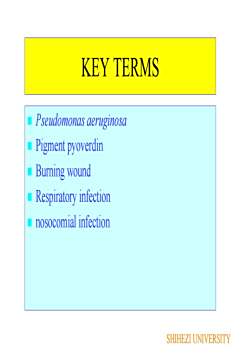
KEY TERMS Pseudomonas aeruginosa Pigment pyoverdinBurning woundRespiratory infectionI nosocomial infectionSHIHEZI UNIVERSITY
KEY TERMS Pseudomonas aeruginosa Pigment pyoverdin Burning wound Respiratory infection nosocomial infection SHIHEZI UNIVERSITY
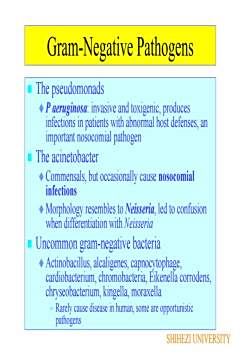
Gram-Negative Pathogens The pseudomonadsP aeruginosa: invasive and toxigenic, producesinfections in patients with abnormal host defenses, animportant nosocomial patho gen The acinetobacter+Commensals, but occasionally cause nosocomialinfectionsMorphology resembles to Neisseria, led to confusionwhen differentiation with NeisseriaUncommon gram-negative bacteria+ Actinobacillus, alcaligenes, capnocytophage.cardiobacterium, chromobacteria Eikenella corrodenschryseobacterium, kingella, moraxellaRarely cause disease in human, some are opportunisticpathogensSHIHEZI UNIVERSITY
Gram-Negative Pathogens The pseudomonads P aeruginosa: invasive and toxigenic, produces infections in patients with abnormal host defenses, an important nosocomial pathogen The acinetobacter Commensals, but occasionally cause nosocomial infections Morphology resembles to Neisseria, led to confusion when differentiation with Neisseria Uncommon gram-negative bacteria Actinobacillus, alcaligenes, capnocytophage, cardiobacterium, chromobacteria, Eikenella corrodens, chryseobacterium, kingella, moraxella Rarely cause disease in human, some are opportunistic pathogens SHIHEZI UNIVERSITY
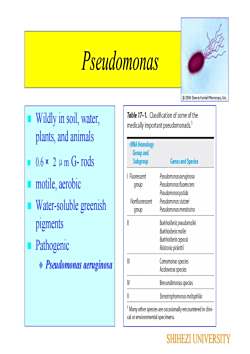
Pseudomonas2004nnisKunkelicrocpy,ITable17-1.ClassificationofsomeoftheWildly in soil, water,medically important pseudomonads.plants and animalsrRNA HomologyGroup and 0.6 × 2 μm G- rodsSubgroupGenus and SpeciesI FluorescentPseudomonas aeruginosaI motile, aerobicPseudomonas fuorescensgroupPseudomonas putidaNonfuorescentPseudomonas stzeri Water-soluble greenishPseudomonas mendocinagroup1Burkholderia pseudomleipigmentsBurholderia malleiBurholderia cepacia PathogenicRalstonia picketiComamonas species+Pseudomonas aeruginosaAcidovorax speciesIVBrevundimonas speciesStenotrophomonas maltophiliaManyherpecieareccasonalynounteredinclincal or environmental specimens.SHIHEZI UNIVERSITY
Pseudomonas Wildly in soil, water, plants, and animals 0.6 × 2 μm G- rods motile, aerobic Water-soluble greenish pigments Pathogenic Pseudomonas aeruginosa SHIHEZI UNIVERSITY
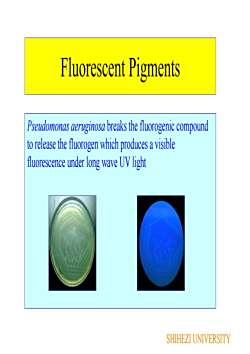
Fluorescent PigmentsPseudomonas aeruginosa breaks the fluorogenic compoundto release the fluorogen which produces a visiblefluorescence under long wave UV lightSHIHEZIUNIVERSITY
Pseudomonas aeruginosa breaks the fluorogenic compound to release the fluorogen which produces a visible fluorescence under long wave UV light Fluorescent Pigments SHIHEZI UNIVERSITY
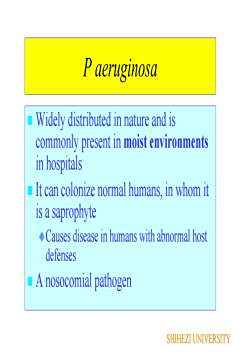
P aeruginosaWidely distributed in nature and iscommonly present in moist environmentsin hospitalsIt can colonize normal humans, in whom itis a saprophyte+Causes disease in humans with abnormal hostdefenses A nosocomial pathogenSHIHEZI UNIVERSITY
P aeruginosa Widely distributed in nature and is commonly present in moist environments in hospitals It can colonize normal humans, in whom it is a saprophyte Causes disease in humans with abnormal host defenses A nosocomial pathogen SHIHEZI UNIVERSITY
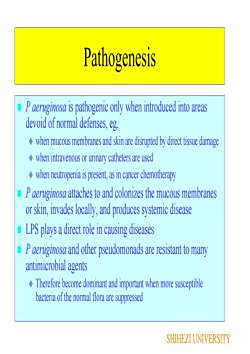
Pathogenesis福P aeruginosa is pathogenic only when introduced into areasdevoid of normal defenses, eg,+ when mucous membranes and skin are disrupted by direct tissue damage+when intravenous or urinary catheters are used+ when neutropenia is present, as in cancer chemotherapy P aeruginosa attaches to and colonizes the mucous membranesor skin, invades locally, and produces systemic disease LPS plays a direct role in causing diseasesP aeruginosa and other pseudomonads are resistant to manyantimicrobial agents+Therefore become dominant and important when more susceptiblebacteria ofthe normal flora are suppressedSHIHEZIUNIVERSITY
Pathogenesis P aeruginosa is pathogenic only when introduced into areas devoid of normal defenses, eg, when mucous membranes and skin are disrupted by direct tissue damage when intravenous or urinary catheters are used when neutropenia is present, as in cancer chemotherapy P aeruginosa attaches to and colonizes the mucous membranes or skin, invades locally, and produces systemic disease LPS plays a direct role in causing diseases P aeruginosa and other pseudomonads are resistant to many antimicrobial agents Therefore become dominant and important when more susceptible bacteria of the normal flora are suppressed SHIHEZI UNIVERSITY
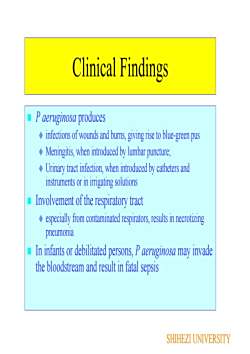
Clinical Findings P aeruginosa producesinfections of wounds and burns, giving rise to blue-green pus+ Meningitis, when introduced by lumbar puncture'Urinary tract infection, when introduced by catheters andinstruments or in irrigating solutionInvolvement of the respiratory tractepeciallyfrom contaminated respirators,results innecrotizingpneumoniaIn infants or debilitated persons, P aeruginosa may invadethe bloodstream and result in fatal sepsisSHIHEZI UNIVERSITY
Clinical Findings P aeruginosa produces infections of wounds and burns, giving rise to blue-green pus Meningitis, when introduced by lumbar puncture; Urinary tract infection, when introduced by catheters and instruments or in irrigating solutions Involvement of the respiratory tract especially from contaminated respirators, results in necrotizing pneumonia In infants or debilitated persons, P aeruginosa may invade the bloodstream and result in fatal sepsis SHIHEZI UNIVERSITY
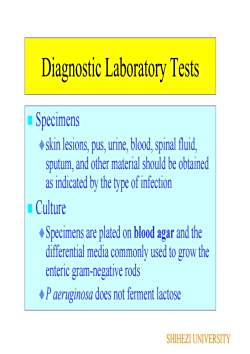
Diagnostic Laboratory TestsSpecimensskin lesions, pus, urine, blood, spinal fluidsputum, and other material should be obtainedas indicated by thetype ofinfectionCultureSpecimens are plated on blood agar and thedifferential media commonly used to grow theenteric gram-negative rodsP aeruginosa does not ferment lactoseSHIHEZI UNIVERSITY
Diagnostic Laboratory Tests Specimens skin lesions, pus, urine, blood, spinal fluid, sputum, and other material should be obtained as indicated by the type of infection Culture Specimens are plated on blood agar and the differential media commonly used to grow the enteric gram-negative rods P aeruginosa does not ferment lactose SHIHEZI UNIVERSITY
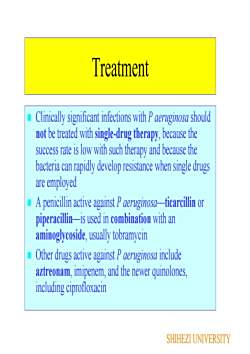
TreatmentClinically significant infections with P aeruginosa shouldnot be treated with single-drug therapy, because thesuccess rate is low with such therapy and because thebacteria can rapidly develop resistance when single drugsare employed A penicillin active against P aeruginosa-ticarcillin orpiperacillinis used in combination with anaminoglycoside, usually tobramycinOther drugs active against P aeruginosa includeaztreonam, imipenem, and the newer quinolones.including ciprofloxacinSHIHEZI UNIVERSITY
Treatment Clinically significant infections with P aeruginosa should not be treated with single-drug therapy, because the success rate is low with such therapy and because the bacteria can rapidly develop resistance when single drugs are employed A penicillin active against P aeruginosa— ticarcillin or piperacillin— is used in combination with an aminoglycoside, usually tobramycin Other drugs active against P aeruginosa include aztreonam, imipenem, and the newer quinolones, including ciprofloxacin SHIHEZI UNIVERSITY
按次数下载不扣除下载券;
注册用户24小时内重复下载只扣除一次;
顺序:VIP每日次数-->可用次数-->下载券;
- 《病原生物学(医学微生物学)》课程教学课件(英文)19A_Haemophilus_Bordetella.pdf
- 《病原生物学(医学微生物学)》课程教学课件(英文)22_Lab Diagnosis for Bacterial Infections.pdf
- 《病原生物学(医学微生物学)》课程教学课件(英文)21_Non-spore-forming G+ bacilli_Corynebacterium_Listeria_Actinomycetes.pdf
- 《病原生物学(医学微生物学)》课程教学课件(英文)20_Yersinia_Pasteurella.pdf
- 《病原生物学(医学微生物学)》课程教学课件(英文)19B_Brucella_Francisella.pdf
- 《病原生物学(医学微生物学)》课程教学课件(讲稿)01 绪论.pdf
- 《病原生物学(医学微生物学)》课程教学课件(讲稿)02 细菌形态结构.pdf
- 《病原生物学(医学微生物学)》课程教学课件(讲稿)09-1 微生物感染的病原学检查法.pdf
- 《病原生物学(医学微生物学)》课程教学课件(讲稿)03 细菌生理.pdf
- 《病原生物学(医学微生物学)》课程教学课件(讲稿)06 真菌的基本性状.pdf
- 《病原生物学(医学微生物学)》课程教学课件(讲稿)05 病毒基本性状.pdf
- 《病原生物学(医学微生物学)》课程教学课件(讲稿)07 微生物感染与致病机制.pdf
- 《病原生物学(医学微生物学)》课程教学课件(讲稿)08 抗感染免疫.pdf
- 《病原生物学(医学微生物学)》课程教学课件(讲稿)09-2 微生物感染的预防原则.pdf
- 《病原生物学(医学微生物学)》课程教学课件(讲稿)10 微生物感染的控制.pdf
- 《病原生物学(医学微生物学)》课程教学课件(讲稿)13 奈瑟菌属.pdf
- 《病原生物学(医学微生物学)》课程教学课件(讲稿)12 链球菌属.pdf
- 《病原生物学(医学微生物学)》课程教学课件(讲稿)11 葡萄球菌属.pdf
- 《病原生物学(医学微生物学)》课程教学课件(讲稿)14 埃希菌属菌.pdf
- 《病原生物学(医学微生物学)》课程教学课件(讲稿)16 沙门菌属.pdf
- 《病原生物学(医学微生物学)》课程教学课件(英文)18_Virio_Vampylo_Helico.pdf
- 《病原生物学(医学微生物学)》课程教学课件(英文)10_Staphylococcus.pdf
- 《病原生物学(医学微生物学)》课程教学课件(英文)12_Nesseria.pdf
- 《病原生物学(医学微生物学)》课程教学课件(英文)13_Enterobacteriaceae.pdf
- 《病原生物学(医学微生物学)》课程教学课件(英文)07_Normal microbial flora.pdf
- 《病原生物学(医学微生物学)》课程教学课件(英文)06_Bacteria Pathogenesis.pdf
- 《病原生物学(医学微生物学)》课程教学课件(英文)04_Microbial Metabolism.pdf
- 《病原生物学(医学微生物学)》课程教学课件(英文)05_Bacteria Genetics.pdf
- 《病原生物学(医学微生物学)》课程教学课件(英文)08_Spore-forming G+ bacilli_Clostridia.pdf
- 《病原生物学(医学微生物学)》课程教学课件(英文)02_Bacteria Growth_Survival_Death_01.pdf
- 《病原生物学(医学微生物学)》课程教学课件(英文)03_Cultivation of Microorganisms.pdf
- 《病原生物学(医学微生物学)》课程教学课件(英文)03_BacterialPhysiology.pdf
- 《病原生物学(医学微生物学)》课程教学课件(英文)00_Introduction.pdf
- 《病原生物学(医学微生物学)》课程教学课件(英文)01_BacterialStructure.pdf
- 《病原生物学(医学微生物学)》课程教学课件(2012)第36章 真菌学总论.pdf
- 《病原生物学(医学微生物学)》课程教学课件(2012)第35章 阮粒(Prion).pdf
- 《病原生物学(医学微生物学)》课程教学课件(2012)第37章 主要病原性真菌.pdf
- 《病原生物学(医学微生物学)》课程教学课件(2012)第34章 其他病毒.pdf
- 《病原生物学(医学微生物学)》课程教学课件(2012)第33章 反转录病毒.pdf
- 《病原生物学(医学微生物学)》课程教学课件(2012)第28章 急性胃肠炎病毒(Acute gastroenteritis virus).pdf
